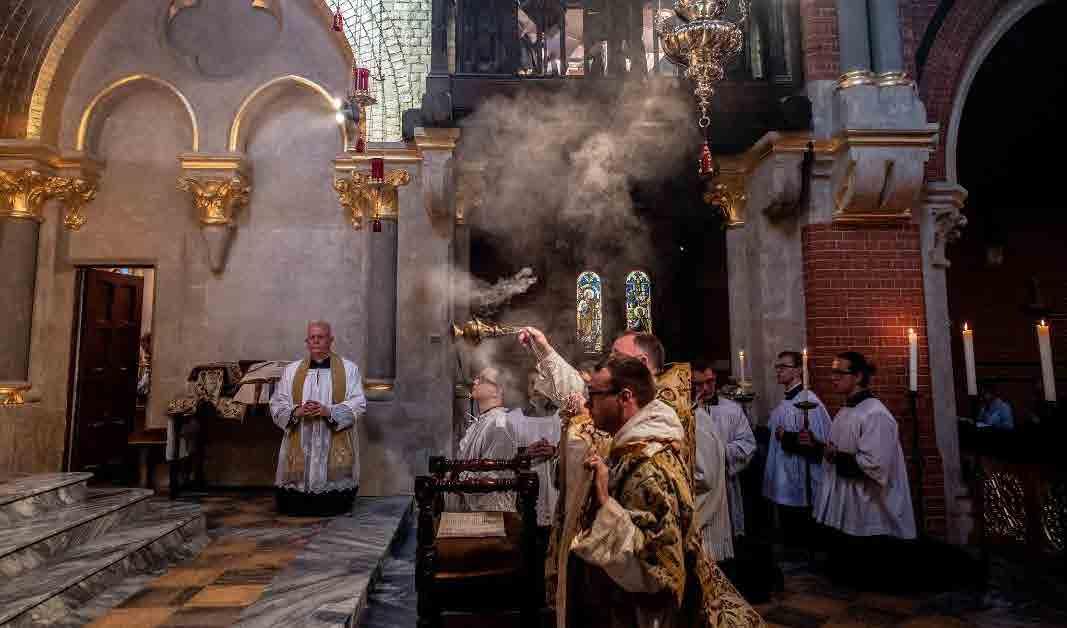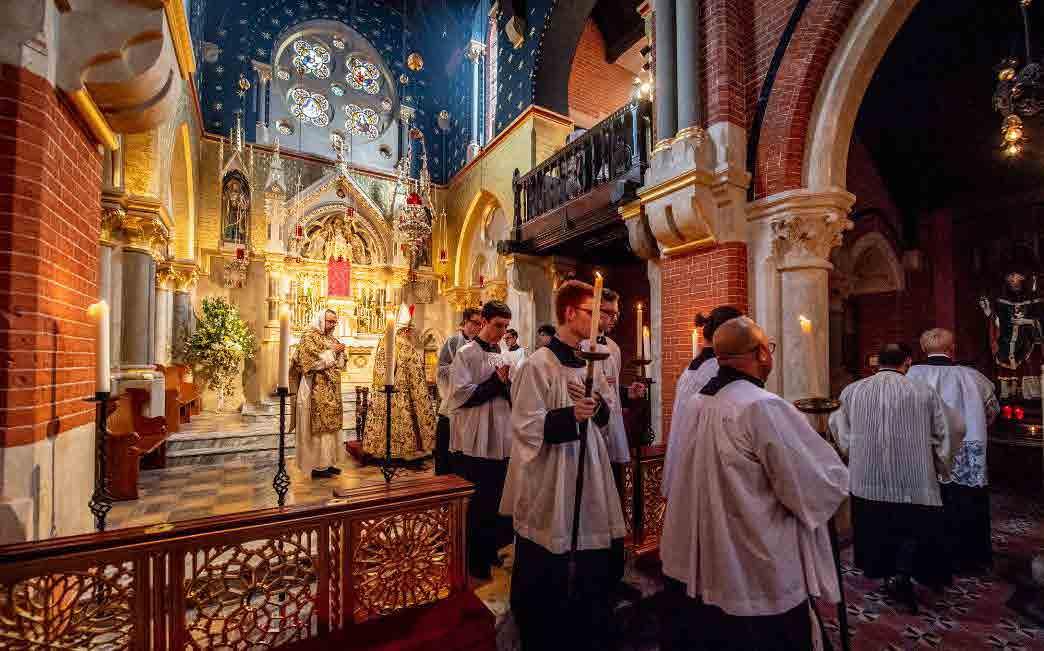
5 minute read
The Church of Corpus Christi Maiden Lane
By Paul Waddington
My first encounter with Corpus Christi Church in Maiden Lane was on 15 August 1953. I was aged four, but still remember the occasion well. In those days, my family lived in Surrey, and we took our summer holidays at Southwold in Suffolk. The 140-mile journey used to take most of the day in our elderly Austin car, which rarely completed the journey without breaking down.
This particular year, our holiday started on the Feast of the Assumption, so we set off fairly early in the morning, expecting to find a Mass in London, which we did at Maiden Lane. It was a Sung Mass, a completely new experience for me. Even as a four-year old, I was stunned by the beauty of the polyphonic music, which may well have been Palestrina. The choir was in a gallery to the right of the High Altar, and I remember that, although I could just see the conductor waving his arms, the singers were completely out of sight.

Mass in the restored interior
Shafts of Coloured Light
I also remember the shafts of co loured light emanating from the stained glass windows above the sanctuary. These were constantly changing, and frequently dulled by clouds of incense smoke, which, from time to time, billowed up from below. Also new to me was seeing rack upon rack of votive candles, all ablaze, and generating light that was almost dazzling.
All this w as 65 y ears a go, but the experience made such an impression on me that it remains one of m y most vivid childhood memories. I can remember nothing of the remainder of the journey to Southwold, or indeed of the subsequent holiday. A t the age of f our, I was too young to notice the architectural features of the church. To get an appreciation of these I had to wait more than 60 years till the next time I visited Corpus Christi Church.
Covent Garden
In 1872, at the behest of Cardinal Manning, Fr Cornelius Keens set about establishing a church that would serve the numerous, but generally poor, Catholics living and working around Covent Garden. There had been no Catholic church in the area since 1854, when Fr Faber moved his Oratorian community from their temporary premises in King William Street to Brompton.
Fr Keens was something of a specialist in creating new parishes in London. He had been responsible for the building of the Sacred Heart Church in Holloway which had opened in 1870, and later went on to o pen more London churches. F or his Maiden Lane church, Fr Keens chose as his architect Frederick Hyde Pownall (1792-1880) , the same architect as had designed the Holloway church.
It seems that Frederick Pownall designed churches in his spare time, as his day job was County Surveyor for Middlesex, which required that he design many public buildings, including the Middlesex Guildhall, Coldbath Fields Prison and Banstead Lunatic Asylum. He was also responsible for several Anglican churches, including the very High Church of St Peter in Wapping, which was consecrated in 1866. He must have converted to Catholicism soon after this, as by 1868 he was working on the Sacred Heart Convent in Hove (now Cardinal Newman School), which opened in 1870. His other Catholic projects include the Carmelite Monastery of the Most Holy Trinity in Notting Hill and the church and school of St Thomas of Canterbury at Grays in Essex.

The restoration has taken the church back as far as possible to its original appearance
To build Corpus Christi Church, a site in Maiden Lane was leased from the Duke of Bedford, who insisted that the church should have an imposing frontage and cost more than £6,000. In fact, the cost was £8,000, and Pownall's frontage, comprising presbytery and church, is indeed impressive, although it is not easily appreciated in such a narrow street.
The foundation stone was laid in 1873 and the church, which was dedicated to the Blessed Sacrament, was opened in 1874. It was a restricted site, and Pownall had to use every inch of the available space to achieve even a modest sized church.
The Maiden Lane frontage, which is the west end of the church, is mostly taken up with a rather squat tower with a steep pyramidal roof. Within the structure of the tower is a gothic window of four lights with cinquefoil roundel in the tracery above. The adjacent four story presbytery is perhaps more imposing. Alongside the tower, is a modest gothic arch which leads to steps down to the nave of the church. After such an unprepossessing entrance, the cosiness of the interior is refreshing.
The nave is relatively narrow, with four arch arcades to either side giving onto side aisles. Above the arcading, there are clerestory windows, surprisingly with rounded heads. It seems that, although Pownall chose to build in a generally Early English Gothic style, he was comfortable introducing Romanesque features. Another unexpected feature is Pownall's choice of red brick as a finish for most of the internal walls. The Lady Chapel, now a shrine to Our Lady of Walsingham, is in the left (Gospel side) aisle. An altar dedicated to the Sacred Heart and statues of various saints are fitted in elsewhere.
Pownall put his best efforts into the design of the sanctuary, where the High Altar stands before a monumental re-redos containing a tall monstrance throne presided over by angels swinging thuribles. Above is an impressive east window made up of four quatrefoil lights which are arranged so that the plate tracery forms a distinctive cross. Although the sanctuary is narrow, he managed to fit in the usual three altar steps.
Few people would describe Frederick Hyde Pownall as a great church architect, especially when compared with the Pugins or the Hansoms; but, in his Maiden Lane building, he did create a church which is much admired and beloved by those who use it.

The restricted Corpus Christi site presented a challenge to the architect
Corpus Christi Church suffered from some rather brutal redecoration in the 1970s. Many of the features were either removed or overpainted, and most surfaces were either whitewashed, or covered with that most horrible invention, artex! The altar belonging to the Lady Chapel was removed and placed at the front of the sanctuary as a forward altar.
Recent restoration work has reversed this damage, and done much to beautify the sanctuary, enhancing Pownall's original design. The ubiquitous whitewash and artex has been removed revealing the original brickwork, and the forward altar restored to the Lady Chapel, where it has been given a marble re-redos. Much gilt has been used highlighting features in the stonework of the columns and the re-redos. In the sanctuary, the walls have been painted gold, and the ceiling blue with stars added. Unsuitable carpet has been removed to reveal a tiled floor, which has been beautifully restored.
With communion rails reinstated, the High Altar of Corpus Christi Church is now a perfect setting for the Traditional Mass, which is celebrated there every Monday evening at 6.30pm.









